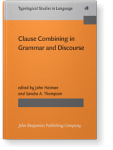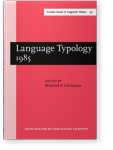Johanna Nichols
List of John Benjamins publications for which Johanna Nichols plays a role.
Journal
2022 Drastic demographic events triggered the Uralic spread Diachronica 39:4, pp. 490–524 | Article
The widespread Uralic family offers several advantages for tracing prehistory: a firm absolute chronological anchor point in an ancient contact episode with well-dated Indo-Iranian; other points of intersection or diagnostic non-intersection with early Indo-European (the Late… read more
2019 Suppletion or illusion? The diachrony of suppletive derivation Perspectives on Language Structure and Language Change: Studies in honor of Henning Andersen, Heltoft, Lars, Iván Igartua, Brian D. Joseph, Kirsten Jeppesen Kragh and Lene Schøsler (eds.), pp. 345–356 | Chapter
Constructing a typology and cross-linguistic survey for Aktionsart, actionality, and related notions is largely infeasible at present because so few Aktionsart systems have been fully described, they are typically complex and intricately dependent on verbal semantics and classification, and despite… read more
2017 Noun-modifying constructions and relativization in the central and western Caucasus Noun-Modifying Clause Constructions in Languages of Eurasia: Rethinking theoretical and geographical boundaries, Matsumoto, Yoshiko, Bernard Comrie and Peter Sells (eds.), pp. 179–201 | Article
Languages of the Nakh-Daghestanian family in the central and eastern Caucasus uniformly use gap strategies for relativization and GNMCC’s, despite different contact histories. Languages to the west and southwest (West Caucasian, Kartvelian) are very different, using relative pronouns and finite… read more
2015 Chapter 10. Types of spread zones: Open and closed, horizontal and vertical Language Structure and Environment: Social, cultural, and natural factors, De Busser, Rik and Randy J. LaPolla (eds.), pp. 261–286 | Article
Spread zones are areas where any resident language is likely to spread out widely, so overall linguistic diversity is low at any time (though over time different languages spread out, giving the area a diverse diachronic profile). This chapter subclassifies spread systems into four types: (1)… read more
2014 Chapter 3. Derivational paradigms in diachrony
and comparison Paradigm Change: In the Transeurasian languages and beyond, Robbeets, Martine and Walter Bisang (eds.), pp. 61–88 | Chapter
Wordlists used for subgrouping and long-range comparison under-utilize the verbal lexicon, and comparative work of all kinds makes more use of lexical roots and inflectional morphology than word formation. This chapter is a first attempt to utilize derivational morphology of verbs, in particular… read more
2010 Chapter 2. Indeterminate motion verbs are denominal New Approaches to Slavic Verbs of Motion, Hasko, Victoria and Renee Perelmutter (eds.), pp. 47–65 | Article
Slavic indeterminate verbs of motion are better analyzed as denominal verbs than as causatives. They owe their *-o- vocalism, their *-i- stem suffixes, and their indeterminate aspectuality to their denominal origin. Some of them may originally have been Indo-European causatives, but were reanalyzed… read more
2008 Case in Ingush syntax Case and Grammatical Relations: Studies in honor of Bernard Comrie, Corbett, Greville G. and Michael Noonan (eds.), pp. 57–74 | Article
This paper reviews the morphological and syntactic patterns and the patterns of lexical derivation in Ingush (Nakh-Daghestanian, Caucasus) in pursuit of a typological generalization about alignment in the language. Morphological case paradigms are almost entirely ergative. Simple clause alignment… read more
2007 The Growth and Maintenance of Linguistic Complexity. By Östen Dahl Diachronica 24:1, pp. 171–178 | Review
2005 Inclusive-exclusive as person vs. number categories worldwide Clusivity: Typology and case studies of the inclusive–exclusive distinction, Filimonova, Elena (ed.), pp. 49–72 | Chapter
2003 The Nakh-Daghestanian Consonant Correspondences Current Trends in Caucasian, East European and Inner Asian Linguistics: Papers in honor of Howard I. Aronson, Holisky, Dee Ann and Kevin Tuite (eds.), pp. 207–264 | Article
2001 Why “me” and “thee”? Historical Linguistics 1999: Selected papers from the 14th International Conference on Historical Linguistics, Vancouver, 9–13 August 1999, Brinton, Laurel J. (ed.), pp. 253–276 | Article
1995 Diachronic stable structural features Historical Linguistics 1993: Selected papers from the 11th International Conference on Historical Linguistics, Los Angeles, 16–20 August 1993, Andersen, Henning (ed.), pp. 337–356 | Article
1993 Transitive and causative in the Slavic lexicon: evidence from Russian Causatives and Transitivity, Comrie, Bernard and Maria Polinsky (eds.), pp. 69–86 | Article
1991 Grammaticalization as retextualization Approaches to Grammaticalization: Volume I. Theoretical and methodological issues, Traugott, Elizabeth Closs and Bernd Heine (eds.), pp. 129–146 | Article
1990 Some preconditions and typical traits of the Stative-Active language type (with reference to Proto-Indo-
european) Language Typology 1987: Systematic Balance in Language, Lehmann, Winfred P. (ed.), pp. 95–114 | Article
1988 Nominalization and assertion in scientific Russian prose Clause Combining in Grammar and Discourse, Haiman, John and Sandra A. Thompson (eds.), pp. 399–428 | Article
1986 On from and content in typology Language Typology 1985: Papers from the Linguistic Typology Symposium, Moscow, 9–13 Dec. 1985, Lehmann, Winfred P. (ed.), pp. 141–162 | Article
1983 Switch-reference in the Northeast Caucasus Switch Reference and Universal Grammar: Proceedings of a symposium on switch reference and universal grammar, Winnipeg, May 1981, Haiman, John and Pamela Munro (eds.), pp. 245–266 | Article
1980 Pidginization and foreigner talk: chinese pidgin russian Papers from the Fourth International Conference on Historical Linguistics, Stanford, March 26–30 1979, Traugott, Elizabeth Closs, Rebecca Labrum and Susan C. Shepherd (eds.), pp. 397–407 | Article



















